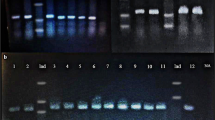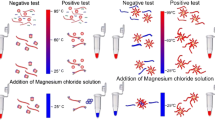Abstract
In the last few years, gold nanoparticle biosensors have been developed for rapid, precise, easy and inexpensive with high specificity and sensitivity detection of human, plant and animal pathogens. Klebsiella pneumoniae serotype K2 is one of the common gram-negative pathogens with high prevalence. Therefore, it is essential to provide the effective and exclusive method to detect the bacteria. Klebsiella pneumoniae serotype K2 strain ATCC9997 genomic DNA was applied to establish the detection protocol either with thiol-capped oligonucleotide probes and gold nanoparticles or polymerase chain reaction based on K2A gene sequence. In the presence of the genomic DNA and oligonucleotide probes, a change in the color of gold nanoparticles and maximum changes in wavelength at 550-650 nm was achieved. In addition, the result showed specificity of 15 × 105 CFU/mL and 9 pg/μL by gold nanoparticles probes. The lower limit of detection obtained by PCR method was 1 pg/μL. Moreover, results demonstrated a great specificity of the designed primers and probes for colorimetric detection assay and PCR. Colorimetric detection using gold nanoparticle probe with advantages such as the lower time required for detection and no need for expensive detection instrumentation compared to the biochemical and molecular methods could be introduced for rapid, accurate detection of the bacteria.










Similar content being viewed by others
References
Gabig-Ciminska M (2006) Developing nucleic acid-based electrical detection systems. Microb Cell Factories 5:9–9
Mehrotra P (2016) Biosensors and their applications – a review. J Oral Biol Craniofac Res 6(2):153–159
Wang L, Song S, Pan D, Li D, Fan C (2010) Gold nanoparticle-based sensing strategies for biomolecular detection. Pure Appl Chem 82(1):81–89
Li Y, Schluesener HJ, Xu S (2010) Gold nanoparticle-based biosensors. Gold Bull 43(1):29–41
Zeng S, Yong K-T, Roy I, Dinh X-Q, Yu X, Luan F (2011) A review on functionalized gold nanoparticles for biosensing applications. Plasmonics 6(3):491–506
Huang X, El-Sayed MA (2010) Gold nanoparticles: optical properties and implementations in cancer diagnosis and photothermal therapy. J Adv Res 1(1):13–28
Wang Z, Ma L (2009) Gold nanoparticle probes. Coord Chem Rev 253(11):1607–1618
Xia F, Zuo X, Yang R, Xiao Y, Kang D, Vallee-Belisle A, Gong X, Yuen JD, Hsu BB, Heeger AJ, Plaxco KW (2010) Colorimetric detection of DNA, small molecules, proteins, and ions using unmodified gold nanoparticles and conjugated polyelectrolytes. Proc Natl Acad Sci 107(24):10837–10841
Ma Z, Tian L, Wang T, Wang C (2010) Optical DNA detection based on gold nanorods aggregation. Anal Chim Acta 673(2):179–184
Hu J, Ni P, Dai H, Sun Y, Wang Y, Jiang S, Li Z (2015) Aptamer-based colorimetric biosensing of abrin using catalytic gold nanoparticles. Analyst 140(10):3581–3586
Khan SA, Singh AK, Senapati D, Fan Z, Ray PC (2011) Targeted highly sensitive detection of multi-drug resistant salmonella DT104 using gold nanoparticles. Chem Commun 47(33):9444–9446
Sattarahmady N, Tondro GH, Gholchin M, Heli H (2015) Gold nanoparticles biosensor of Brucella spp. genomic DNA: visual and spectrophotometric detections. Biochem Eng J 97:1–7
Cenciarini-Borde C, Courtois S, La Scola B (2009) Nucleic acids as viability markers for bacteria detection using molecular tools. Future Microbiol 4(1):45–64
Borghei Y-S, Hosseini M, Dadmehr M, Hosseinkhani S, Ganjali MR, Sheikhnejad R (2016) Visual detection of cancer cells by colorimetric aptasensor based on aggregation of gold nanoparticles induced by DNA hybridization. Anal Chim Acta 904:92–97
Mirkin CA, Letsinger RL, Mucic RC, Storhoff JJ (1996) A DNA-based method for rationally assembling nanoparticles into macroscopic materials. Nature 382(6592):607–609
Yarbakht M, Nikkhah M (2015) Unmodified gold nanoparticles as a colorimetric probe for visual methamphetamine detection. J Exp Nanosci 11(7):593–601
Larguinho M, Baptista PV (2012) Gold and silver nanoparticles for clinical diagnostics - from genomics to proteomics. J Proteome 75(10):2811–2823
Larguinho M, Canto R, Cordeiro M, Pedrosa P, Fortuna A, Vinhas R, Baptista PV (2015) Gold nanoprobe-based non-crosslinking hybridization for molecular diagnostics. Expert Rev Mol Diagn 15(10):1355–1368
de Souza Lopes AC, Falcao Rodrigues J, de Morais Junior MA (2005) Molecular typing of Klebsiella pneumoniae isolates from public hospitals in Recife, Brazil. Microbiol Res 160(1):37–46
Hsu Y-L, Lin H-C, Yen T-Y, Hsieh T-H, Wei H-M, Hwang K-P (2015) Pyogenic liver abscess among children in a medical center in Central Taiwan. J Microbiol Immunol Infect 48(3):302–305
Chiu SK, Wu TL, Chuang YC, Lin JC, Fung CP, Lu PL, Wang JT, Wang LS, Siu LK, Yeh KM (2013) National surveillance study on carbapenem non-susceptible Klebsiella pneumoniae in Taiwan: the emergence and rapid dissemination of KPC-2 carbapenemase. PLoS One 8(7):e69428
Kabha K, Nissimov L, Athamna A, Keisari Y, Parolis H, Parolis LA, Grue RM, Schlepper-Schafer J, Ezekowitz AR, Ohman DE (1995) Relationships among capsular structure, phagocytosis, and mouse virulence in Klebsiella pneumoniae. Infect Immun 63(3):847–852
Wyres KL, Wick RR, Gorrie C, Jenney A, Follador R, Thomson NR, Holt KE (2016) Identification of Klebsiella capsule synthesis loci from whole genome data. Microb Genomics 2(12):1-15.
Doud MS, Grimes-Zeppegno R, Molina E, Miller N, Balachandar D, Schneper L, Poppiti R, Mathee K (2009) A k(2)A-positive Klebsiella pneumoniae causes liver and brain abscess in a saint Kitt's man. Int J Med Sci 6(6):301–304
Shen DX, Wang J, Li DD (2013) Klebsiella pneumoniae liver abscesses. Lancet Infect Dis 13(5):390–391
Ku Y-H, Chuang Y-C, Yu W-L (2008) Clinical spectrum and molecular characteristics of Klebsiella pneumoniae causing community-acquired extrahepatic abscess. J Microbiol Immunol Infect 41(4):311–317
Brisse S, Passet V, Haugaard AB, Babosan A, Kassis-Chikhani N, Struve C, Decré D (2013) Wzi gene sequencing, a rapid method for determination of capsular type for Klebsiella strains. J Clin Microbiol 51(12):4073–4078
Sikarwar A, Batra HV (2011) Identification of Klebsiella Pneumoniae by capsular polysaccharide polyclonal antibodies. Int J Chem Eng Appl 2(2):130–134.
Gierczynski R, Jagielski M, Rastawicki W, Kaluzewski S (2007) Multiplex-PCR assay for identification of Klebsiella pneumoniae isolates carrying the cps loci for K1 and K2 capsule biosynthesis. Pol J Microbiol 56(3):153–156
Palfreyman JM (1978) Klebsiella serotyping by counter-current immunoelectrophoresis. J Hyg 81(2):219–225
Sikarwar AS (2014) A review on advanced serotyoing methods for identification of klebsiella pnuemoniae capsular serotypes. Indian J Med Res Pharm Sci 1(7):27–33
Mansour AMA, Zaki HM, Hassan NA, Al-Humiany AA (2014) Molecular characterization and immunoprotective activity of capsular polysaccharide of klebsiella pneumoniae isolated from farm animals at taif governorate. Am J Infect Dis 10(1):1–14
Arakawa Y, Wacharotayankun R, Nagatsuka T, Ito H, Kato N, Ohta M (1995) Genomic organization of the Klebsiella pneumoniae cps region responsible for serotype K2 capsular polysaccharide synthesis in the virulent strain Chedid. J Bacteriol 177(7):1788–1796
Toze S (1999) PCR and the detection of microbial pathogens in water and wastewater. Water Res 33(17):3545–3556
Aghababaee H (2012) Comparison of PCR technique with MPN method in identification of coliform Bacteria in water. Arch Sci 65(4):1–5
Kurupati P, Chow C, Kumarasinghe G, Poh CL (2004) Rapid detection of Klebsiella pneumoniae from blood culture bottles by real-time PCR. J Clin Microbiol 42(3):1337–1340
Compain F, Babosan A, Brisse S, Genel N, Audo J, Ailloud F, Kassis-Chikhani N, Arlet G, Decre D (2014) Multiplex PCR for detection of seven virulence factors and K1/K2 capsular serotypes of Klebsiella pneumoniae. J Clin Microbiol 52(12):4377–4380
Fernandez Cuenca F, Lopez Cerero L, Pascual Hernandez A (2013) Molecular typing methods for infection monitoring and control. Enferm Infecc Microbiol Clin 1:20–25
Adzitey F, Huda N, Ali GRR (2013) Molecular techniques for detecting and typing of bacteria, advantages and application to foodborne pathogens isolated from ducks. Biotechnology 3(2):97–107
Queipo-Ortuno MI, De Dios Colmenero J, Macias M, Bravo MJ, Morata P (2008) Preparation of bacterial DNA template by boiling and effect of immunoglobulin G as an inhibitor in real-time PCR for serum samples from patients with brucellosis. Clin Vaccine Immunol 15(2):293–296
Turkevich J, Stevenson PC, Hillier J (1951) A study of the nucleation and growth processes in the synthesis of colloidal gold. Spec Discuss Faraday Soc 11:55–75
Rashid MH, Bhattacharjee RR, Kotal A, Mandal TK (2006) Synthesis of spongy gold nanocrystals with pronounced catalytic activities. Langmuir 22(17):7141–7143
Soo PC, Horng YT, Chang KC, Wang JY, Hsueh PR, Chuang CY, Lu CC, Lai HC (2009) A simple gold nanoparticle probes assay for identification of Mycobacterium tuberculosis and Mycobacterium tuberculosis complex from clinical specimens. Mol Cell Probes 23(5):240–246
Gill P, Alvandi AH, Abdul-Tehrani H, Sadeghizadeh M (2008) Colorimetric detection of Helicobacter pylori DNA using isothermal helicase-dependent amplification and gold nanoparticle probes. Diagn Microbiol Infect Dis 62(2):119–124
Vaseghi A, Safaie N, Bakhshinejad B, Mohsenifar A, Sadeghizadeh M (2013) Detection of Pseudomonas syringae pathovars by thiol-linked DNA–gold nanoparticle probes. Sensors Actuators B Chem 181:644–651
Fu Z, Zhou X, Xing D (2013) Sensitive colorimetric detection of Listeria monocytogenes based on isothermal gene amplification and unmodified gold nanoparticles. Methods 64(3):260–266
Andreadou M, Liandris E, Gazouli M, Taka S, Antoniou M, Theodoropoulos G, Tachtsidis I, Goutas N, Vlachodimitropoulos D, Kasampalidis I, Ikonomopoulos J (2014) A novel non-amplification assay for the detection of Leishmania spp. in clinical samples using gold nanoparticles. J Microbiol Methods 96:56–61
Osmani Bojd M, Kamaladini H, Haddadi F, Vaseghi F (2017) Thiolated AuNP probes and multiplex PCR for molecular detection of Staphylococcus epidermidis. Mol Cell Probes 34:30–36
Shawky SM, Bald D, Azzazy HM (2010) Direct detection of unamplified hepatitis C virus RNA using unmodified gold nanoparticles. Clin Biochem 43(13–14):1163–1168
Prasad D, Shankaracharya, Vidyarthi A (2011) Gold nanoparticles-based colorimetric assay for rapid detection of Salmonella species in food samples. World J Microbiol Biotechnol 27(9):2227–2230
Khalil MA, Azzazy HM, Attia AS, Hashem AG (2014) A sensitive colorimetric assay for identification of Acinetobacter baumannii using unmodified gold nanoparticles. J Appl Microbiol 117(2):465–471
Lesniewski A, Los M, Jonsson-Niedziółka M, Krajewska A, Szot K, Los JM, Niedziolka-Jonsson J (2014) Antibody modified gold nanoparticles for fast and selective, colorimetric T7 Bacteriophage detection. Bioconjug Chem 25(4):644–648
Castilho ML, Vieira LS, Campos APC, Achete CA, Cardoso MAG, Raniero L (2015) The efficiency analysis of gold nanoprobes by FT-IR spectroscopy applied to the non-cross-linking colorimetric detection of Paracoccidioides brasiliensis. Sensors Actuators B Chem 215:258–265
Wang L, Liu Z, Xia X, Yang C, Huang J, Wan S (2017) Colorimetric detection of Cucumber green mottle mosaic virus using unmodified gold nanoparticles as colorimetric probes. J Virol Methods 243:113–119
Kuswandi BG, Agus A, Kristiningrum N, Ahmad M (2017) Simple colorimetric DNA biosensor based on gold nanoparticles for pork adulteration detection in processed meats. Sens Transducers J 208(1):7–13
Ray PC, Fortner A, Griffin J, Kim CK, Singh JP, Yu H (2005) Laser-induced fluorescence quenching of tagged oligonucleotide probes by gold nanoparticles. Chem Phys Lett 414(4):259–264
Ghazi Y, Vaseghi A, Ahmadi S, Haddadi F (2018) Simultaneous expression of GUS and Actin genes by using the multiplex RT-PCR and multiplex gold nanoparticle probes. J Fluoresc 28(2):633–638
Pan HZ, Yu HW, Wang N, Zhang Z, Wan GC, Liu H, Guan X, Chang D (2015) Electrochemical DNA biosensor based on a glassy carbon electrode modified with gold nanoparticles and graphene for sensitive determination of Klebsiella pneumoniae carbapenemase. J Biotechnol 214:133–138
Author information
Authors and Affiliations
Corresponding author
Rights and permissions
About this article
Cite this article
Ahmadi, S., Kamaladini, H., Haddadi, F. et al. Thiol-Capped Gold Nanoparticle Biosensors for Rapid and Sensitive Visual Colorimetric Detection of Klebsiella pneumoniae. J Fluoresc 28, 987–998 (2018). https://doi.org/10.1007/s10895-018-2262-z
Received:
Accepted:
Published:
Issue Date:
DOI: https://doi.org/10.1007/s10895-018-2262-z




